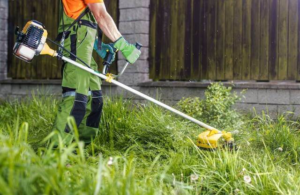Commercial Landscaping Services are the planning, design, installation and maintenance of aesthetically pleasing outdoor business spaces. Beautiful working environments have been shown to increase output by employees and attract more clients to businesses.

Maintaining a well-groomed landscape also helps protect your property and creates safety for visitors, tenants in multifamily housing and residents at assisted living facilities. Proper walkways, stairways and ramps are important for people to move safely around the property. Contact Greensboro Commercial Landscaping Services for professional help.
The design of commercial landscaping is a bit different from residential landscaping. Commercial landscapers focus on business or municipal properties (like office buildings, shopping centers, parks, and even industrial complexes). The overall goal is to create aesthetically pleasing and functional outdoor spaces that meet the property’s practical needs while reflecting the company’s brand image and ambiance.
When done correctly, a commercial landscape can make an excellent first impression, and it can be one of the deciding factors in whether people choose to spend their money with that business. This is why it’s important to use a commercial landscape service that has a great track record of delivering exceptional results.
Choosing the right plant species, colors, textures and shapes is essential to creating a landscape that’s both beautiful and practical. For example, plants can help filter air pollutants and increase humidity, which reduces the need for air conditioning in hot weather. They can also add color and texture to an otherwise flat area, which can improve visual appeal.
A well-designed landscape can boost property values and attract customers, which can lead to greater profitability for businesses that rely on foot traffic. It can also provide an opportunity to increase energy efficiency through the use of natural shading and windbreaks. Additionally, well-maintained commercial landscapes can reduce operational costs by reducing the need for watering and other maintenance services.
Commercial landscaping includes both softscapes (plants) and hardscapes (pathways, seating areas, etc.). A professional landscaper will assess the property to understand its layout, soil type, climate, and existing vegetation before developing a comprehensive plan. The plan will include a list of goals and objectives, along with the desired aesthetic and functional outcomes. The design phase also involves the development of a budget and timeline, and the preparation of a detailed blueprint.
In addition to enhancing the appearance of the property, commercial landscaping can also improve employee morale and boost customer satisfaction. Moreover, it can enhance the safety of employees and visitors by providing proper lighting, snow removal, and ice prevention. Finally, it can reduce energy costs by incorporating green strategies like water and air conservation, erosion control, and stormwater management.
Installation
A commercial landscape has many benefits for businesses, including enhancing curb appeal, increasing property value, and making a positive impression on customers. It can also help increase productivity and make business sense. However, it is important to have the right team to design and maintain the landscape. A professional landscaping company will be able to meet the needs of each client, ensuring that their outdoor space is functional and attractive.
The main services offered by commercial landscaping companies include lawn maintenance, landscape installation, tree care and arboriculture, water management, horticulture, and snow removal. Commercial landscapers work closely with clients to create aesthetically pleasing outdoor spaces that are in line with the client’s brand image and meet practical needs. A comprehensive set of services allows businesses to have a unified brand image and reduce costs by eliminating the need for multiple contractors or intermediaries.
In addition to these services, commercial landscaping services often include hardscape maintenance, which is the maintenance of paved areas such as sidewalks and driveways. This can be a crucial aspect of business operations, especially for retail stores and restaurants. In addition, hardscapes are also a key feature in many public spaces such as parks and schools.
To grow your commercial landscaping business, it is important to focus on quality and provide exceptional customer service. This will allow you to attract more clients and win more contracts. It is also important to have a strong marketing strategy, which includes developing an online presence, networking, and utilizing targeted advertising.
Commercial landscaping is different from residential landscaping because it involves a greater range of services and higher-value projects. A full-service commercial landscaper will be able to offer all of these services, saving businesses money and time by not having to coordinate with multiple vendors. Additionally, a full-service company can complete the entire project from start to finish, allowing them to deliver more value and ensure that the final product meets all expectations.
When quoting for commercial landscape jobs, it is important to understand the scale and complexity of the project. This will help you develop a more accurate quote and ensure that the services are customized to the client’s specifications. In addition, implementing a customer relationship management (CRM) tool like Zentive can help you automate communication with clients and improve efficiency.
Maintenance
Commercial landscaping maintenance is a vital part of any business’s exterior. It helps keep properties looking clean and professional, which can help draw in more customers and clients. The maintenance includes regular mowing and trimming of grass, hedges, shrubs, and trees. It also may include pest control to keep insects from damaging plants and causing damage to the property.
The service can also include weeding and mulching. This helps maintain the health of the landscape and prevents weeds from growing, as well as retaining moisture in the soil. It can also include seasonal planting to keep colors vibrant during warmer weather, and adjustments in irrigation based on rainfall and temperature changes.
A top-rated commercial landscaping service will have an on-staff horticulturist to provide specialized expertise for any problem areas that may appear. This can be helpful to businesses with large plantings that could be susceptible to disease or insect infestations. It is also important for the horticulturist to be able to identify potential problems early so that they can take measures to mitigate or eradicate them.
When hiring a commercial landscape maintenance company, it is important to choose one that understands the unique needs of each type of business. For example, a medical facility will have different maintenance needs than an office building or retail space. The landscape should be designed to match the business’s brand and culture. It should also be mindful of any safety concerns, such as making sure walkways are clear in winter.
Another way to grow your commercial landscape maintenance services is by offering competitive quotes. This is important because it will help attract and retain clients, which will lead to more revenue in the long run. You can do this by creating a comprehensive and detailed quote that outlines all the elements of the work that you will be providing.
Finally, you can expand your services by promoting your business through marketing efforts like website development and social media advertising. You can also partner with local schools to introduce students to the field of horticulture and landscape management. This will allow your company to reach a younger and more diverse audience, which can increase your business’s visibility.
Irrigation
Landscape irrigation systems play a critical role in creating beautiful commercial properties. The system’s layout, water requirements and climatic considerations all impact the success of your business’s outdoor spaces. Commercial landscapers know how to manage these challenges, and they’re skilled at designing, constructing, maintaining and winterizing lawn irrigation systems for commercial properties.
Landscape irrigators are also experts at optimizing water usage and reducing environmental footprints. For example, they can help you reduce the use of fertilizers and chemicals by choosing native plants that are well-adapted to your climate. They can also recommend low-flow fixtures, such as drip irrigation, to improve your water efficiency and minimize the amount of runoff and waste.
In addition to irrigation services, commercial landscapers can install outdoor furniture and other features for your commercial property. These include gazebos, outdoor barbeques and seating areas, fountains, and signage. These features are known to increase workplace productivity and attract clients. They’re also great for promoting brand image and creating a welcoming environment.
The exterior of a commercial space is often the first impression that potential customers have of your business. A poorly maintained landscape can create a negative perception of your company and turn away clients. Alternatively, an attractive landscape can promote a positive perception of your business and boost the value of your property.
Commercial Landscaping Services involve planning, designing and installing aesthetically appealing outdoor business spaces that align with your brand image and meet practical needs. This can include ensuring that all outdoor spaces are safe and welcoming, promoting a healthy working environment, and providing a positive experience for your clients and employees.
If you’re looking to grow your landscaping business, focusing on commercial work can be a great way to increase revenue and client numbers. In addition, offering a full range of seasonal and offseason services can help you gain more profit opportunities. A good example is offering snow removal services during the winter and holiday lighting installation in the fall, which can be a lucrative source of income for your landscaping business. Also, using a landscape job estimating software can help you streamline the entire process, improving your quoting efficiency and accuracy.

